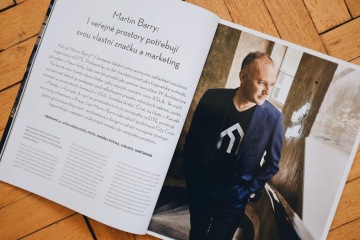
Martin Barry for ESTATE Magazine: Public Spaces Also Need Branding
Story was originally published in Estate Magazine's May 2018 Edition & written by Jitka Krulcova
Who is Martin Barry?
In the context of the local scene, he is the head of the nonprofit organization reSITE. He could professionally be characterized as a landscape architect, born in New York, where he worked as an associate at W Architecture for eight years. He also earned the highest award in his field, the ASLA President's Award. At thirty-eight years old, he has worked on magnificent projects in such as waterfronts, brownfields, parks, squares and university campuses in the US, Saudi Arabia, China, Haiti, Canada, in Mexico and Europe. And now, through the already mentioned reSITE, he focuses on urban development and architecture in Prague and other European cities. Last year, Martin Barry also founded City Crew, whose repertoire includes branding, architecture and urban design, and creating development strategies that encourage the involvement of private investment in the public space.
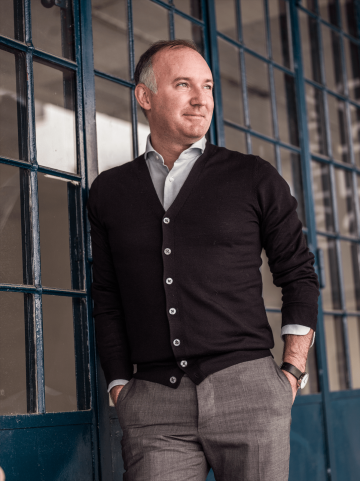
As reSITE’s founder, you are one of the most visible actors of the current discussion about the evolution of the public space in Prague. What do you identify as its major problems?
It’s true - we’ve become thought leaders in the discussion about Prague’s public space, but also about all facets of urban development and architecture. reSITE is one of the only groups in Prague that is sought after by international media, investors and brands to advise or comment on the state of development and urbanism.
Those who listen and know me well, they know I never use the word "problem". Problems are negative and impose the attitude that there are few possible solutions. We take complications as challenges because challenges give courage and motivation to search for and find innovative and pragmatic solutions. As in all cities, Prague is facing a number of challenges.
I personally accept failure as part of the game, and the way to the right solution. I like searching for options no one else found. Think about your favorite cities all over the world. Then remember how they are represented on postcards. Most of them show well-used public space or inspiring architecture. It can be said almost with certainty that the most expensive real estate in that city will be found near those spaces because people want to live and work in the heart of cities, in places with good infrastructure and quality public space. There is a clear line betwee those high quality spaces the value of adjacent real estate. It's one metric. To create quality and useful public space, there is a need for investment and leadership with a vision. If investment and political will are available to implement good solutions and work with the private and civic sector, then anything is possible.
A good example of this is the Mayor of Calgary Naheed Nenshi or former Mayor of New York Michael Bloomberg, and Alain Juppe of Bordeaux. These men have convinced investors and developers to invest in countless public spaces and buildings in their cities and in many cases, we see the enormous impacts of the upcoming investments in public space on the real estate market itself. But to your question - in Prague I would like to see more partnerships between the public and private sector. When the private sector is on board with improving the quality of the urban environment, it is much more difficult to slow down development.
In 20 years, there will be flying cars from Slovakia; nice, multi-lingual robot taxi drivers from Tokyo; a 3-hr Hyperloop connection from Holesovice to Bejing. Now, seriously...
Public space is closely related to the work of developers. Can you point out any recent projects that are cultivating it?
Let’s start elsewhere - my client in Calgary invested roughly $300 million (CAN) at the start of a 26-hectare development project. In ten years they sold 99% of their (unbuilt) parcels for over $2bn CAN. We have won multiple awards for the public space work there, before anyone ever moved in. It took vision, political will, private partnerships and willingness to work with the top global consultants like our firm, and others in outside cities like Toronto, Paris or London who brought the vision and skills to add value to the client’s project.
Florentinum by Jakub Cigler Architects has offered useful and needed a privately-owned-public spcae that is used by employees in the buildings and passerby. There is a green courtyard, nice access to the area and trees on the street – in a part of the city that is like an ecological and public space desert.
Public projects should rally developers, as well. One recent proposal that investors should get behind is Negrelli Viaduct in Karlin. It was opened last summer for temporary cultural and creative use. Developers with interests anywhere near this vicinity should back the continued use of this space and suggest it be partially for commercial / gastro use to keep it diverse and financially viable. The payoff in the surrounding districts will be massive.
The Vaclavske namesti renovation will also have major impacts and if done properly the adjacent businesses will be smart to refine their business model to attract a more sophisticated and higher paying clientele to the square that will demand different services and features than currently exist. The food scene here will change as a result, and it should. But – the shift needs to be planned carefully with new strategies for branding and business development by people who know what they’re doing. That’s right – public spaces need their own brand and marketing.
You often mention the competitiveness of Prague as a place to live and work and the competition of other cities. Who are biggest competitors for Prague?
I think it’s the wrong question to ask. The question is “what is Prague doing to compete?” Unfortunately, a lot of people think Prague is still just a good place to visit for a few days and not a place to relocate a company or family. I’ve made the argument that in the wake of Brexit the city could be seen as a premier long-term destination. But, it would have to get up to speed quickly with more agile and suitable cities like Amsterdam, Dublin, Frankfurt, and Vienna. And, they need to do it quickly. This would be a huge benefit for the private sector and tax base, of course.
I would like to see the municipality and government shift gears to focus on promoting the vibrant cultural and creative scene, reasonable cost of living, lots of parks, good transit and a stable economy. It would do a lot to make serious bids for foreign talent to boost the economy to improve transit connections to the rest of Europe. The City also needs to allow developers to build infill at brownfields at a faster rate then currently allowed, as there is tremendous pressure in the office and residential sectors now. It can be done properly and quickly.
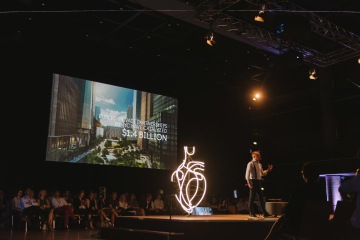
You founded reSITE in 2012 and prepare now the 7th edition of your international conference. Do you observe any major changes in the metropolitan urbanism and city planning strategy since then?
I have noticed a huge change in the discussion and action related to urbanism and city planning. There are several factors for the change, but I think reSITE deserves a lot of the credit for bringing urbanism into the 21st century in Prague, and countless other Czech towns and cities whose staff or mayors have visited reSITE events or followed our media channels.
When I started reSITE not many people understood what I was talking about relative to sustainable urbanism, smart and livable cities. Since then, two Prague mayors have made metropolitan planning their core topic. The City has embarked on a new Strategic Plan and Metropolitan Plan, published new building regulations and a public space manual, and launched dozens of competitions for public space, bridges and streets. The airport – a subject of an international workshop at reSITE 2014, is now being redeveloped with local and international consultants. The city has also hired Jan Gehl, the legendary Danish public space architect who is planning the future of the Magistrala. He was a keynote speaker at our first event. One of my board members, Mark Johnson from Denver is now regularly in Brno to help J&T Bank and the City of Brno with the relocation of the main train station. Along with our friends pushing for change, reSITE has catalyzed a lot of this.
I must also be frank – I’ve seen a lot of talk, and I’m now ready for action because I haven’t seen enough of it. It takes too long to build. It’s one of the reasons that reSITE will make big changes.
The future of Prague largely depends on the Metropolitan Plan. How the will city look like in 20 years?
There will be flying cars from Slovakia; nice, multi-lingual robot taxi drivers from Tokyo; a 3-hr
Hyperloop connection from Holesovice to Bejing; and a Chinese Embassy in Prague Castle. Oh, and why travel to ride the London Eye when you can take a copy for a spin in Smichov!
Seriously, some of that might happen, but the more tangible reality is there will be more density and less peripheral urbanization. In ten years, the brownfields of Prague 3-Zikov, Prague 5-Smichov and Prague 7-Holesovice can be inhabited and connected with the rest of the city. The most difficult part of this, other than finding the will and leadership to get it done, will be for the city to work with the developers to integrate these new neighborhoods into the city fabric and make them vibrant places where people want to live or invest. This isn’t a given. It’s as much a strategy and design question as it is a financing, community or and politics one. This combination is what makes urbanism so challenging, and that’s what makes reSITE so vital. No challenge can be solved by one person or one firm alone. We bring the ideas and creative strategies and experts who’ve done it before to solve any problem.
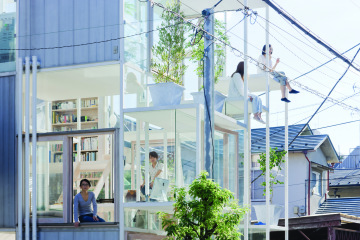
What are your program picks for reSITE?
Sou Fujimoto. Jeanne Gang. Rojkind. OMA. MINI Living. Airbnb. So much to be proud of! But I must point out that it is not just about watching scenes and listening to these big brains, reSITE’s main thing was always to meet and talk with people who may be our future partners, consultants, and authors of major ideas. We have offers to bring reSITE to other cities in the world, and that shows that what we do resonates in Europe and overseas.
Which locations do you speak of, specifically?
reSITE events and media has been expanding with projects in Berlin and Lisbon with global partners, from the EMEA policy team at Airbnb (UK), Meyer Sound (US) and the MAAT Museum (PT) respectively. Meyer Sound and I are in early conversation to expand and launch new projects in San Francisco and New York in 2018-2019. We are also being considered for the creative and content work for another project in New York by one of the world’s largest fintech players who want to work on smart city strategy and like our approach. We signed on MOU with CityPossible by Mastercard, and we hope to announce more on that later this quarter.
The Mayor and Vice Mayor of Lisbon have made an offer to start a major reSITE collaboration in Lisbon. We are in negotiations now and hope to work with them to create and implement pilot projects in housing and mobility, and run a major global event in 2019 to highlight the work being done by us, and the city. We will make a decision about reSITE Lisbon in the coming months.
That is a lot.
That being said – we’re busy! I recently came to the realization that I need to consolidate our activities because we’re growing and need a new structure to manage it all more efficiently.
reSITE is still a nonprofit organization and our main event – the annual conference in Prague is still noncommercial. Meaning, that we focus on content first, and it’s really difficult to raise the money we need to host over 50 international speakers and 1500 guests at our main event. I have been working for two years to attract a long-term sponsor to provide the organization some sense of security. But, so far it’s been elusive. It’s just a tough market for this kind of thing in this region. The events have had huge impact so I am able to fundraise, but face different obstacles every year and spend about 70% of my time doing it – taking me away from the creative work I really excel at.
Do you want to drop the non-profit status of reSITE?
I will keep the nonprofit going only if I can secure long-term funding from a visionary philanthropist or company who believes in the things we do and has the vision to be committed to it. Tough to find, but I never lose hope.
Now, besides reSITE, what are your next projects?
We are in the midst of big changes at reSITE. It’s really exciting. We have grown beyond a public space expert to become an end-to-end creative and strategic advisory because of our powerful and huge network, and our ability to look at challenges with creative solutions.
One of the hardest things for entrepreneurs and startups to do is pivot. I am ready to pivot. And, look forward to all of the bumps and risks I’ll face while doing it. We naturally have to grow and change and now feels like the right time.
Already I have started two other companies. City Crew is a creative and strategic advisory focused on architecture, urbanism, culture, and real estate projects and clients. One of our most fun projects right now is a brewery and restaurant expansion for Captain Lawrence Brewery, New York’s largest and most widely distributed microbrew beer. We also recently completed a branding project for a real estate development in Prague.
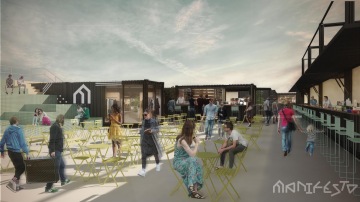
Can you tell us more about the project?
It was for the consortium of developers Karlín Group and Horizon. We created a name, brand and visual identity of the Zahálka project, a small residential area which is located on the former brownfield in Prague 4 near the Vltava river.
But, our most exciting project is called MANIFESTO, a new cultural and gastro temporary popup market in the heart of Prague. We will completely transform the empty brownfield next to Masarykovo nadrazi into a vibrant place with shipping containers and a cultural program that we hope will attract locals and foreigners for a completely unique gastro and cultural experience. It’s only possible because of the network of partners I put together across the public, private and culture sectors.
How did you acquire such an exceptional plot?
The land was kindly offered to us by Penta Real Estate before their planned project returns to life to claim this site permanently and completely transform it.
The heart of the cultural partnership is with Aerofilms (behind Kino Svetozor, Cobra Bar, Aero Bar and others) who will manage the project when it opens. Ivo Suchomel and his Dejsiprostor is excelling with our leasing concept. MasterCard Europe is also on board. Together, we aim to make this the first cashless development in the region. You can buy a beer or a steak with your app or credit card, but leave your cash at home! The cultural program and gastrohub will open in June.
It sounds really revolutionary and ambitious. How big is the project?
The entire market will be four times larger than we originally thought when we were in the first year of design in the Superstudio Contest students' competition. We have developed the architecture of the project with one of the winning teams and eventually, there will be 28 stands plus facilities.
And when does it all begin?
A cultural program will be launched in June and the market will open June 8th.
Do you already have partners for these activities?
In addition to the already mentioned major partners, part of the outside furnishing is provided by Czech designer mmcité. We consulted with the Chamber of Commerce for Prague 1 and the project won the auspices of the City of Prague. We will be communicating with appropriate local artists and looking for awe-inspiring culinary artists. At Manifesto we find the best of Prague gastro brands, who want to bring new concepts, and we don't yet know exatly what they'll come up with…yet.
